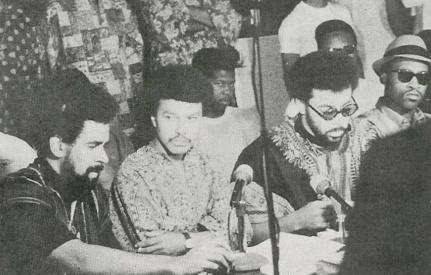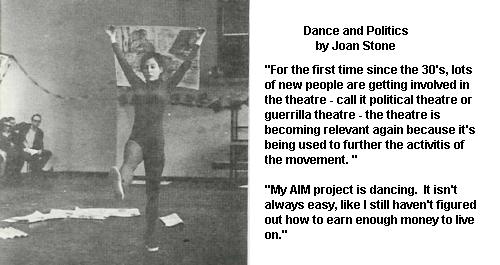Stories
The Black Panthers
in New Haven
The American
Independent Movement
Union-Organizing at Yale
* * *
Hundreds, perhaps even thousands, of New Left organizations sprang up around the world and around the United States at the end of the 60's. In New Haven, those of us who had been active in the Cook for Congress Campaign formed an organization that we called the "American Independent Movement", searching for a name as neutral as possible.
Many of us had come to New Haven to study or work at Yale University, belonging to what the communists call the "petit bourgeoisie." AIM itself was "lily white" (one of the things that attracted me later to the Communist Party instead was its insistance on Black/white unity and their ability, though not always consistent, to develop Black leadership in the Party itself). AIM did, however, develop strategic alliances with organizations in the Black, working class community, beginning with the Hill Parents Association at the time of the two Cook for Congress Campaigns.

Press Conference of Hill Parents Association with Richard Thornell, Freddy Harris, Ronnie Johnson and Willie Counsel
Freddy Harris of the Hill Parents Association was an especially attractive and effective leader. I once tape-recorded his speech to a street rally and put it into my novel PEACE. But his language was so much more colorful than anything I could write that it stuck out in the book like a sore thumb, exposing my lack of skills as a novelist. Ronnie Johnson, another HPA leader was trapped by a government COITTELPRO sting operation and went to prison for having threatened to dynamite the police station. Ronnie told me once, "Don't drive down Dagget Street at night. One car will pull out blocking your path in front, and another behind, and I'll come the window of your car wearing a mask, brandishing a pistol and you'll have to give me your wallet."
Later we worked with the Black Panther Party. As one of the editors of the AIM Newsletter, which later became Modern Times, I interviewed a young black militant in 1966 named John Hudgins, who had just returned from Vietnam where he felt he fought on the wrong side. John then went to California where he married a girl named Erika. She was pregnant with his daughter when he was assassinated as part of the Cointelpro conspiracies of the government. Several years later Erika came to New Haven to organize for the Panthers where she got caught up in the famous murder trial. Many years later their daughter enrolled at Wesleyan when I was teaching there, but when I tried to tell her I had known her father, she didn't want to talk, saying that "I had no father."
One of the Black Panthers who joined the Communist Party became a good friend of mine for many years: Craig Gauthier. Craig rose to the leadership of the machinist union at the Winchester gun factory in New Haven where he led several successful strikes and an expose of illegal shipments of arms to the South African apartheid regime. Craig was from Louisiana; he invited me to take a trip down South with him on motorcycles. I was tempted but never went.
We did a bit of union organizing of the white collar workers at Yale. And mostly we discussed radical ideas, ran a few political campaigns and tried to establish alternative enterprises. Many of these enterprises exist to this day. In New Haven, AIM members helped establish the High School in the Community, the Hill and Fair Haven Health Clinics, and the Advocate Press. Some of our institutions did not last, such as the coffeehouse Bread and Roses. I worked on the newspaper Modern Times which lasted only a few years, but some of its staff and spirit became the basis for the New Haven Advocate, and much later, the New Haven Independent. Nina became the first director of the Fair Haven Health Clinic.
One of the organizations I helped organize was the Science Action Group at Yale, which mobilized against the Vietnam War and for other progressive issues. Although the organization only lasted a couple of years, I have remained close to some of its members ever since, including Henry Lowendorf and Tony Dominski who were graduate students in physiology and the Yale Forestry School, respectively.
As usual in an academic community like Yale, there was extensive turnover of people coming and going. The average AIM activist took part for two or three years and then moved on to seek professional advancement in some other state. Seeing that this would ultimately weaken the movement, a small group of us pledged each other that we would put down roots in the New Haven community and not leave. This included those of us who had started the first Cook for Congress Campaign back in 1966: Rick Wolff and his wife Harriet Fraad, Harris and Joan Stone (who had grown up in New Haven), and Nina and me. It also included Matt Borenstein and his wife Florie Ricciuti who were working on Modern Times and High School in the Community.

|
Rick Wolff, who had come to Yale as a graduate student in economics, was a "born organizer." Rick's parents had escaped to America at the last moment from Nazi Germany, and Rick, as a child was put into an American kindergarten, where his parents expected him to learn English. But after some time, when he continued to come home speaking German, they enquired of the teacher who told them that instead of learning English Rick had taught the other kids to speak German.
After working together on the Cook campaign and Modern Times, Rick and his wife Harriet Fraad and Nina and I bought a house together in 1970 on East Pearl Street in the Fair Haven section of New Haven. Many of our meetings were held there, and at various times, young colleagues lived on our third floor. For a time, even, John Wilhelm, who later became a high-ranking union leader in the US, lived next door.
The dispute at Modern Times led to the breakup of our household, and Nina and I bought out the share of Rick and Harriet and rented to other activists, including Lynne Karsten who worked with Nina on the Yale Non-Faculty Organizing Committee and Hank Murray who took a job as an organizer with the United Auto Workers. Although we did not continue to work together those who had pledged to do so, remained in New Haven for the most part. The only ones to move away were Harris and Joan Stone, which was ironic since they were the only ones who had grown up in New Haven. I stayed in the area by working as a post-doc at Yale and then getting a professorship at nearby Wesleyan University where I worked for 25 years.
I have never regretted the decision to stay in New Haven, since it provides me with a base of friendships and acquaintances that is so often lacking for Ameican academics. Of course, I left for some periods of time, including trips to the Soviet Union and almost 10 years with UNESCO in Paris, but always I have returned to the New Haven area.
 |
Stages
1986-1992
Fall of Soviet Empire
1992-1997
UNESCO Culture of Peace Programme